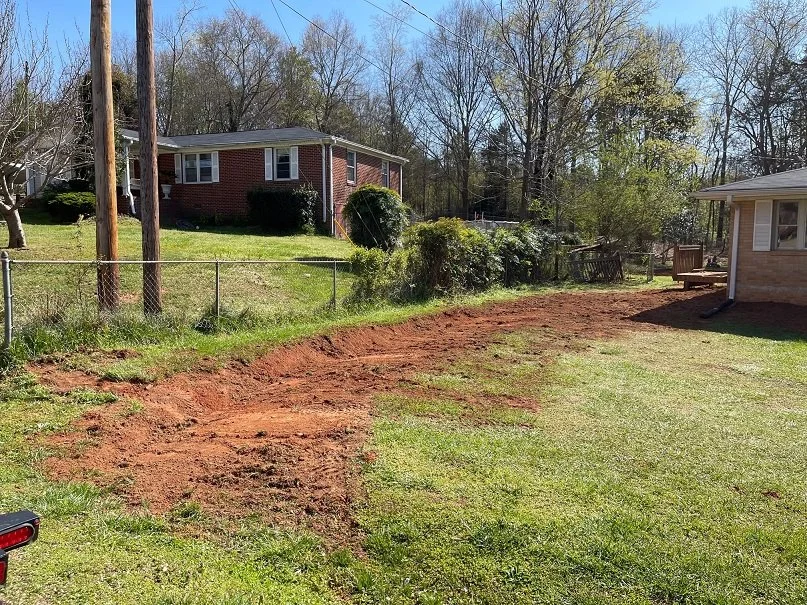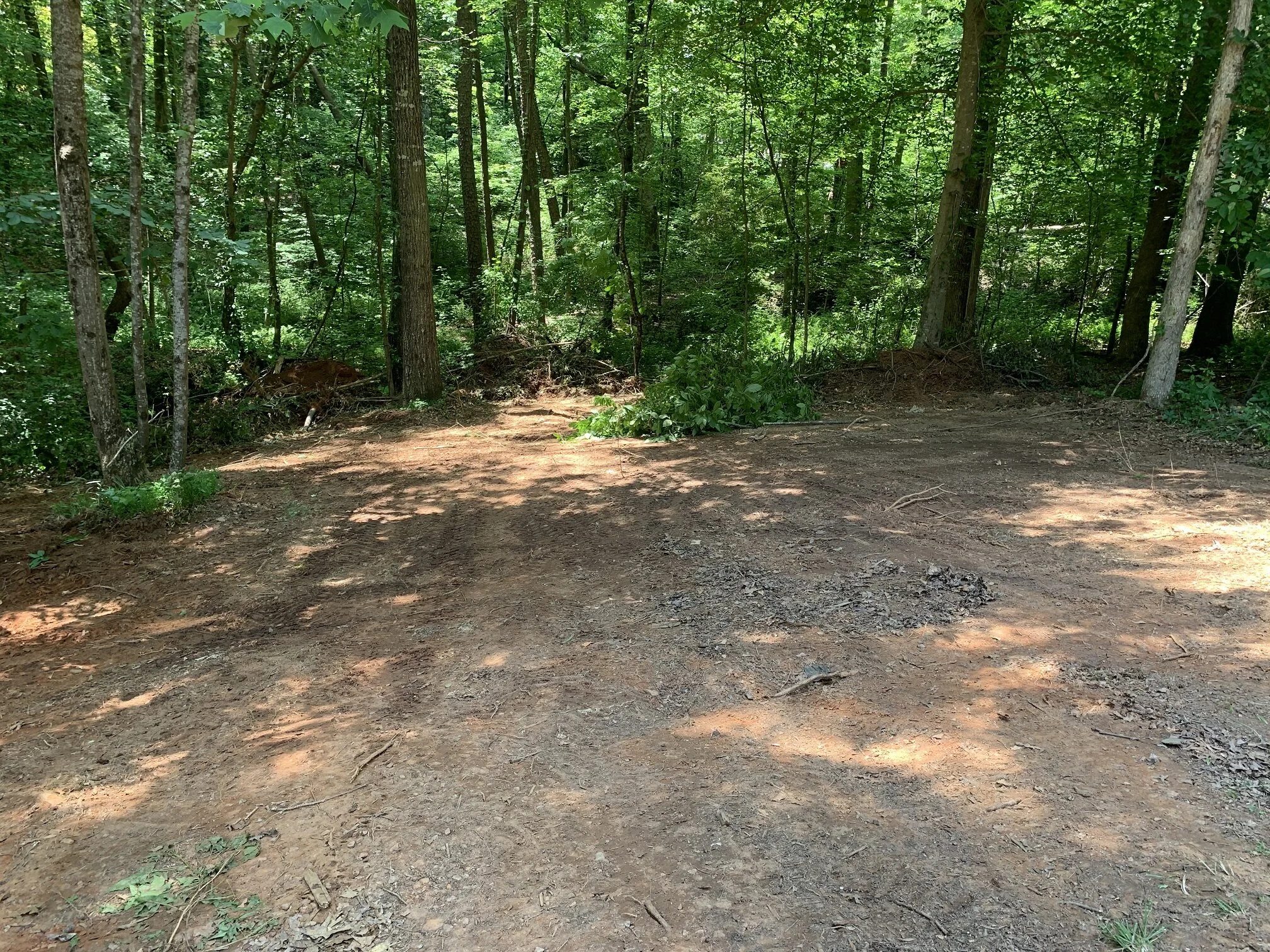Fixing Surface Water Issues
In this project, the homeowner’s neighborhood had a continuous slope, and water from the neighbor’s uphill property was causing trouble in low spots and in the homeowner’s basement. An example can be seen in this photo from early in the project. Under the deck facing the uphill side, the ground was about 3 feet below where it needed to be to slope away from the house, likely contributing to water in the basement.
The homeowner wanted to raise the ground level on this side of the house to create a slope away from the house.
To do this, we decided to till the higher area in the back yard and take about 6 inches of dirt from there.
There were also a few lumpy areas heading into the front yard we wanted to smooth while we had the equipment there. We ended up tilling those areas and smoothing as well. Additionally, some of the runoff didn’t have a clear path to the ditch in front of the house. We also tilled a path out to the ditch and shaped a swale to give the water a clear path.
Here you can see we’ve raised the ground about 3 feet at the house and created about a 6 inch drop as it slopes away. This directs water behind the house and into the swale we cut that runs to the ditch in the front.
The swale that we cut runs parallel to the fence on the property line. The picture does not do justice to the slopes involved. There is a drop from the high point at the house to the ditch in front of about 1.5 feet.
This angle from the rear of the house shows the slope down into the back yard, where the runoff naturally flows away from the house.
While we had freed up the dirt, the homeowner also had us raise a low spot behind his garage in the backyard a few inches to ensure any water in the backyard continued to flow to the ditch below the property. Due to the wetness of the dirt we were working with, the back dragging we did to smooth this area wasn’t perfect, but it was uniform and could probably be seeded with minimal raking.
As we stated with the low spot, the dirt we were working with was too wet to get a fine, powdery consistency to allow for smooth finishing. After demonstrating the smearing and clumping result of trying to backdrag the area that we had tilled and transferred dirt from, the homeowner decided to till the area one more time and leave it that way since it was uniform. He intends to rake a little if needed before seeding.
Overall, this project took about 6 hours to complete. The customer was very satisfied we would be successful and keeping his basement dry and evacuating water from the property efficiently without low spots.
Reclaiming overgrowth
This customer wanted to reclaim the area on one side and to the rear of his house. The growth was 6-8 feet tall in most areas and very thick. He also wanted a 90 foot trench dug to his RV parking area. I decided to till the growth under to give him a workable surface to reseed with.
The approached worked very well. In half a day he had a leveled, growth free yard and trench ready for conduit.
Clearing Out Unwanted Growth
This growth was approximately 20 feet across and about 10 feet high. Once we started clearing it out, we discovered there was a sizable cedar tree/bush in the middle.
In about an hours time, the growth was piled street side, and we were beginning to relocate some sod from another spot on the property where we were prepping for a sidewalk installation.
French Drain
This customer had some water issues in his crawl space, and was putting in a French drain himself. Not having any equipment of his own, he had us dig out the space for the drain along the front of the house.
By doing all of the other work himself, this client was able to save a substantial amount of money. We were able to save his back though and take care of the heavy digging.
“Bush Hogging”
While this tractor isn’t an ideal machine for “bush hogging” due to how low to the ground it is, it will do a great job, albeit slower due to the smaller cutter. This was a 7 acre project for a former coworker who needed to knock down the growth on a new property he purchased.
Parking Area Creation
Initial Status
The area was heavily wooded, and on a very steep slope. The first thing we did was clear out all of the trees and brush and get a clear surface to work with.
We’re going to need a lot of dirt.
What you can’t see in the images is how steep this slope is. We got 66 tons of fill dirt delivered to build up the parking area. The intent was not to make the area perfectly level. That would have required well over 100 tons of fill dirt. We want to leave a small amount of slope to both save some money and allow for good run-off.
Time to build the slope.
We used the 66 tons of fill dirt to shape a more gentle slope. We also had to dig the ground beside the existing drive way down a bit, so that we we added the crusher run, we’d have a t least 4 inches of it starting at the asphalt.
Don’t scrimp.
We wanted to make sure all of the fill dirt stays in place where we want it, so we got 44 tons of crusher run to ensure we have at least 4 inches of coverage on the parking surface, and a couple inches on each side of the build up.
Final spread.
We spread out the crusher run and had a perfect amount of material. The result is a long, gently sloped parking area big enough for multiple long trailers. Now we just need some rain to pack it down and lock it in.
Post Stump Grinding Clear-Out
Initial Status
This customer had a stand of Cedar trees, some quite large, removed and had the stumps ground. They hired us to remove the chips, leaf litter, and roots so they could prep it for seeding.
The Process
The area was full of large roots and stumps that were not ground. We had to work inch by inch to rip, dig, or cut out the roots and drag loose material into mounds with the backhoe so we could scoop them up with the bucket. A lot of people think if they have stumps ground that all they need to do is scrape up the chips and they’re good to go. It rarely works that way.
The Result
At the end of a 6 1/2 hour process, the area was ready for the customer to rake out and seed. Something to consider: we can rake it out smooth and even seed it in some cases, but it’s smart to save the money and do the easier parts of a project yourself rather than tie up equipment and pay for hours spent doing the finishing work like raking. We’ll do whatever the customer wants, but we have no problem suggesting ways to save a little money.























